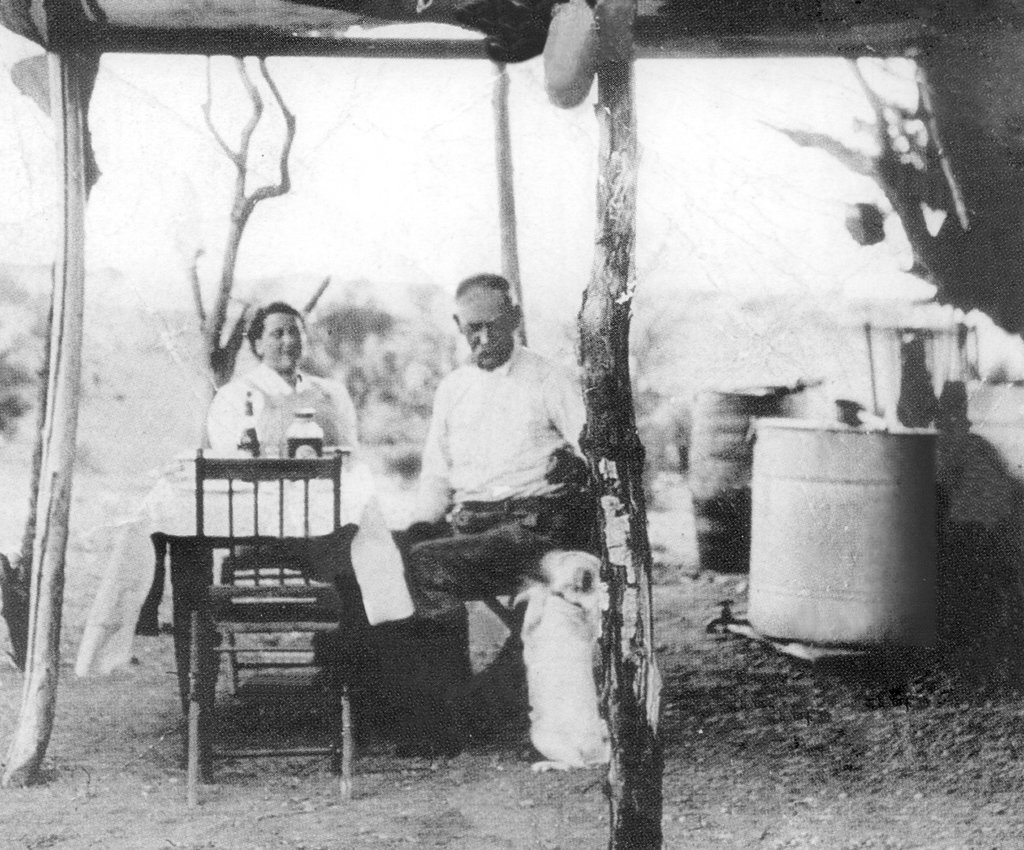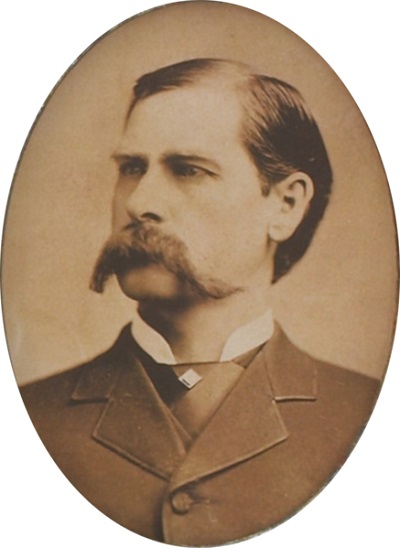by Bruce Wells | Feb 19, 2025 | Petroleum History Almanac
Famed lawman and wife gambled on Kern County oil leases.
Old West lawman and gambler Wyatt Earp and his wife Josie in 1920 bet oil could be found on a barren piece of California scrub land. A century later, his Kern County lease still paid royalties.
Ushered into modest retirement by notoriety, Mr. and Mrs. Wyatt Earp were known — if not successful — entrepreneurs with abundant experience running saloons, gambling houses, bordellos (Wichita, Kansas, 1874), real estate, and finally western mining ventures.

Circa 1906 photo of Wyatt Earp and wife Josie at their mining camp with dog “Earpie.”
Quietly retired in California, the couple alternately lived in suburban Los Angeles or tended to gold and copper mining holdings at their “Happy Days” camp in the Whipple Mountains near Vidal. Josephine “Josie” Marcus Earp had been by Wyatt’s side since his famous 1881 O.K. Corral gunfight in Tombstone, Arizona.
Also in California, Josie’s younger sister, Henrietta Marcus, had married into wealth and thrived in Oakland society while Josie and Wyatt roamed the West. “Hattie” Lehnhardt had the genteel life sister Josie always wanted but never had. When Hattie’s husband Emil died by suicide in 1912, the widow inherited a $225,000 estate.
Money had always been an issue between the Earps, according to John Gilchriese, amateur historian and longtime collector of Earp memorabilia.
Josie liked to remind Wyatt he had once employed a struggling gold miner — Edward Doheny — as a faro lookout (armed bouncer) in a Tombstone saloon. Doheny later drilled for oil and discovered the giant Los Angeles oilfield in the early 1880s.

The Los Angeles field launched southern California’s petroleum industry, creating many unlikely oil millionaires — including local piano teacher Emma Summers, whose astute business sense earned her the title “Oil Queen of California.”
In addition to oilman Doheny, Earp socialized with prominent Californians like George Randolph Hearst (father of San Francisco Examiner publisher William), whom he knew from mining days in Tombstone. But the former lawman’s ride into the California oil patch began in 1920 when he gambled on an abandoned placer claim.
Kern County Lease
In 1901, a petroleum exploration venture had drilled a wildcat well about five miles north of Bakersfield in Kern County. The attempt generated brief excitement, but nothing ultimately came of it. When Shasta Oil Company drilled into bankruptcy after three dry holes, the land returned to its former reputation — worthless except for sheep grazing.
Earp decided to bet on black gold where Shasta Oil had failed. But first, California required that he post a “Notice of Intent to File Prospectors Permit.” He sent his wife to make the application. But on her way to pay the fees with paperwork in hand, Josie was diverted by gaming tables. She lost all the money, infuriating Wyatt and delaying his oil exploration venture.
Earp later secured the Kern County lease claim he sought, mostly with money from his sister-in-law, Hattie Lehnhardt,

Wyatt Earp purchased a mineral lease in Kern County, PLSS (Public Land Survey System) Section 14, Township 28 South, Range 27 East.
The San Francisco Examiner declared, “Old Property Believed Worthless for Years West of Kern Field Relocated by Old-Timers.” The newspaper — describing Earp as the “pioneer mining man of Tombstone” — reported that the old Shasta Oil Company parcel had been newly assessed.
“Indications are that a great lake of oil lies beneath the surface in this territory,” the article proclaimed. “Should this prove to be the case, the locators of the old Shasta property have stumbled on to some very valuable holdings.”
Meanwhile, competition among big players like Standard Oil of California and Getty Oil energized the California petroleum market. By July 1924, Getty Oil had won the competition and began to drill on the Earp lease.

On February 25, 1926, a well on the lease was completed with production of 150 barrels of oil a day. During 1926, nine of the wells produced a total of almost 153,000 barrels of oil. “Getty has been getting some nice production in the Kern River field ever since operations were started,” reported the Los Angeles Times.
Rarely exceeding 300 barrels of oil a day, the Getty wells were not as large as other recent California discoveries (see Signal Hill Oil Boom), but they produced oil from less than 2,000 feet deep, keeping production costs low. Royalty checks would begin arriving in the mail.
With the Oil and Gas Journal reporting “Kern River Front” oil selling for 75 cents per barrel, the Earps received $3,174 from 12 active wells producing 282,116 barrels of oil from February 1927 to January 1928, according to the 2019 book A Wyatt Earp Anthology: Long May His Story Be Told.
At age 78, Wyatt Earp’s oil gamble finally paid off — but there was a catch.
No Royalty Riches
Because of her gambling, Josie Earp had become so notoriously incapable of managing money that Earp gave control of the lease to her younger sister, Hattie Lehnhardt. At the same time, he directed that his wife “receive at all times a reasonable portion of any and all benefits, rights and interests.”
From February 1928 to January 1929, production from the dozen Earp wells declined to 91,770 barrels, “grossing $68,827 with Josie’s royalties amounting to a mere $1,032,” noted the anthology’s editors.

With that, Earp’s venture in the Kern County petroleum business became a footnote to his legend, already well into the making. By the time of his death on January 13, 1929, his gamble on oil, still known as the Lehnhardt Lease, had paid Josie a total of almost $6,000.
The disappointing results would prompt Josie to write, “I was in hopes they would bring in a two or three hundred barrel well. But I must be satisfied as it could have been a duster, too.”
When benefactor Hattie Lehnhardt died in 1936, her children (and some litigation) put an end to the 20 percent of the 7.5 percent of the Getty Oil royalties formerly paid to their widowed aunt Josephine. Eight years later, when Josephine died, she left a total estate of $175, including a $50 radio and a $25 trunk.
The Lehnhardt lease in Kern County would remain active. From January 2018 to December 2022, improved secondary recovery in the Lehnhardt oil properties of the California Resources Production Corporation produced 440,560 barrels of oil, according to records at ShaleXP.
Kern County Museums
Beginning in 1941, the Kern County Museum in Bakersfield has educated visitors with petroleum exhibits on a 16-acre site just north of downtown. The museum offers “Black Gold: The Oil Experience,” a permanent $4 million science, technology, and history exhibition.
The museum also preserves a large collection of historic photographs.

A roughneck monument with a 30-foot-tall derrick was dedicated at in Taft, California, in 2010. Photo courtesy West Kern Oil Museum.
In Taft, the West Kern Oil Museum also has images from the 1920s showing more than 7,000 wooden derricks covering 21 miles in southwestern Kern County, according to Executive Director Arianna Mace.
Run almost entirely by volunteers — and celebrating its 50th anniversary in 2023 — the oil museum collects, preserves, and exhibits equipment telling the story of the Midway-Sunset field, which, by 1915, produced half of the oil in California. The state led the nation in oil production at the time.

Since 1946, Taft residents have annually celebrated “Oildorado.” The community in 2010 dedicated a 30-foot Oil Worker Monument with a derrick and bronze sculptures of Kern County petroleum pioneers.
Both Kern County museums played credited roles in the 2008 Academy Award-winning movie “There Will Be Blood.” Production staff visited each museum while researching realistic California wooden derricks and oil production machinery. During a visit to the West Kern Oil Museum, the film’s production designer purchased copies of authentic 1914 cable-tool derrick blueprints.
______________________
Recommended Reading: A Wyatt Earp Anthology: Long May His Story Be Told (2019); Black Gold in California: The Story of California Petroleum Industry  (2016); Early California Oil: A Photographic History, 1865-1940
(2016); Early California Oil: A Photographic History, 1865-1940 (1985); Pico Canyon Chronicles: The Story of California’s Pioneer Oil Field
(1985); Pico Canyon Chronicles: The Story of California’s Pioneer Oil Field (1985); Black Gold, the Artwork of JoAnn Cowans
(1985); Black Gold, the Artwork of JoAnn Cowans (2009). Your Amazon purchase benefits the American Oil & Gas Historical Society. As an Amazon Associate, AOGHS earns a commission from qualifying purchases.
(2009). Your Amazon purchase benefits the American Oil & Gas Historical Society. As an Amazon Associate, AOGHS earns a commission from qualifying purchases.
_______________________
The American Oil & Gas Historical Society (AOGHS) preserves U.S. petroleum history. Please become an AOGHS annual supporter and help maintain this energy education website and expand historical research. For more information, contact bawells@aoghs.org. © 2025 Bruce A. Wells.
Citation Information – Article Title: “Wyatt Earp’s California Oil Wells.” Authors: B.A. Wells and K.L. Wells. Website Name: American Oil & Gas Historical Society. URL: https://aoghs.org/oil-almanac/wyatt-earps-california-oil-wells. Last Updated: February 18, 2025. Original Published Date: October 30, 2013.







